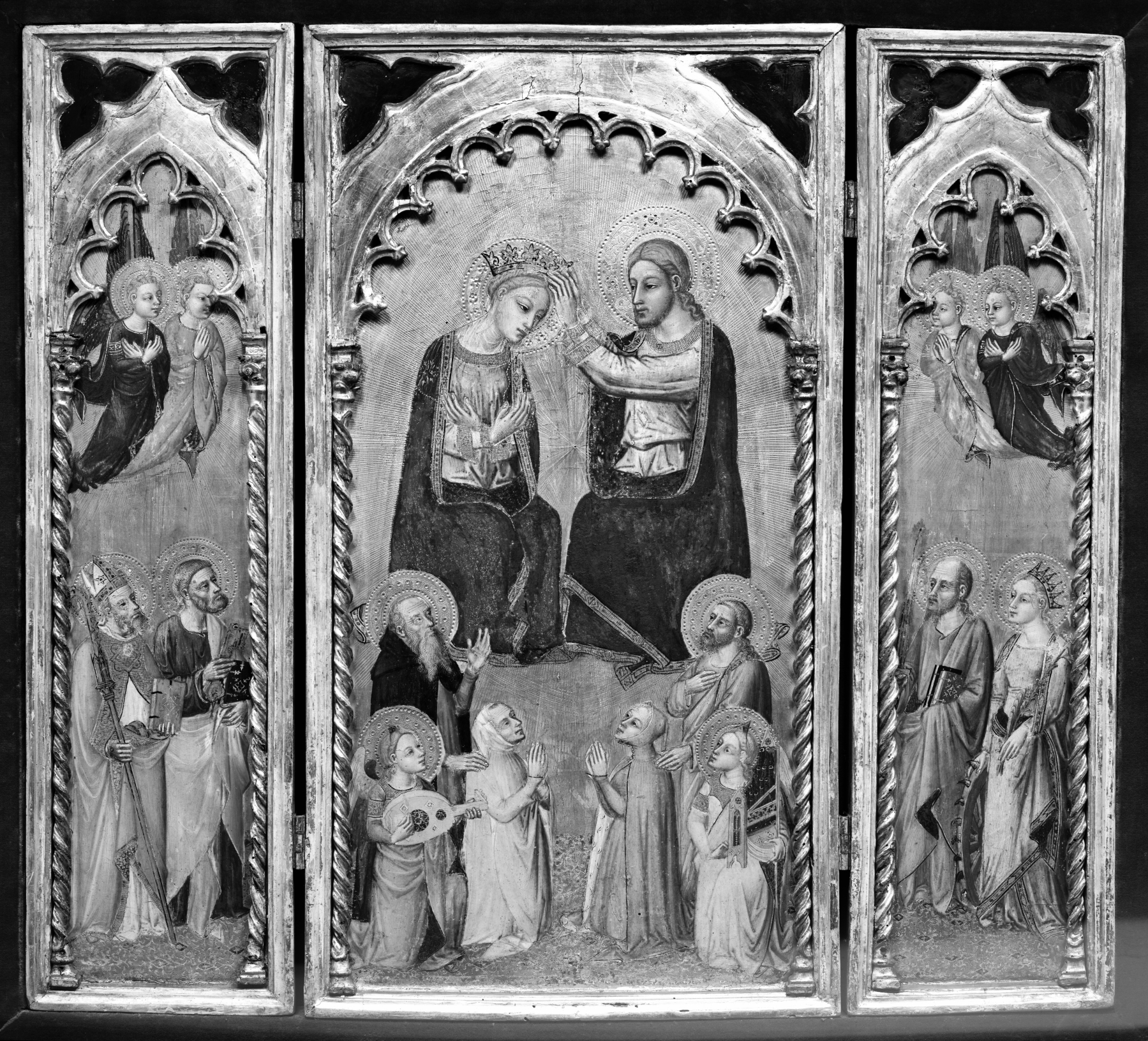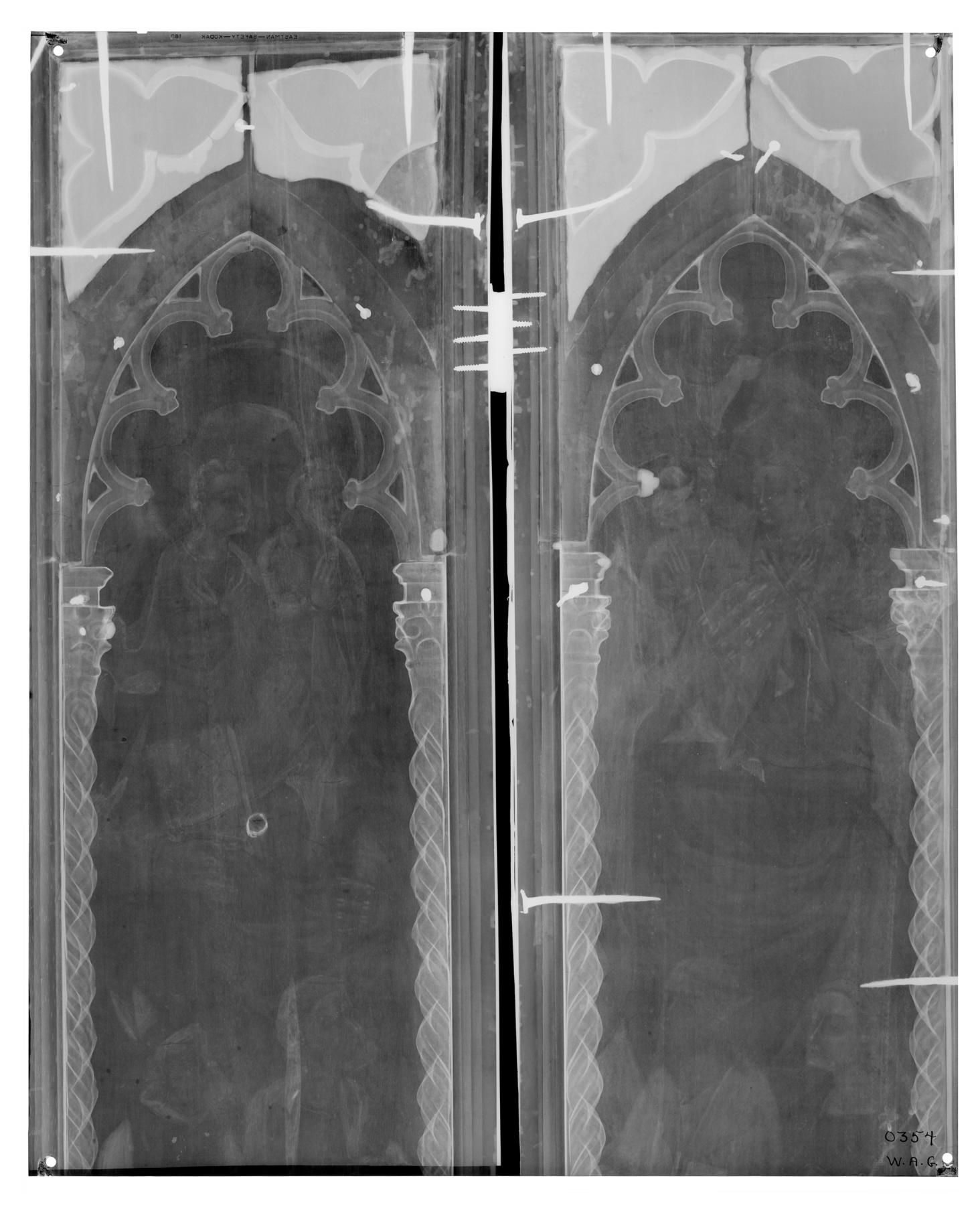The Coronation of the Virgin
(Medieval Europe )
This folding triptych is attributed to the Florentine painter Niccolò di Tommaso, who was active primarily in Tuscany between the years 1346 and 1376. The central panel depicts the coronation of the Virgin Mary upon her entrance into the kingdom of heaven, where she reigns eternal beside Christ. This scene is apocryphal, meaning that it was popularly known but not specifically described in the New Testament. Golden rays enclose the two figures in a mandorla, or full-body halo, as the Virgin bows her head and lowers her eyes to humbly accept her crown. Four seraphic (or six-winged) angels witness the scene from either wing of the triptych, and emit their own less extensive golden rays. The unusual blue glass inlay in the upper spandrels may serve to further evoke the kingdom of heaven, while the similarly unusual green and gold floor pattern seems to resemble a luxurious carpet where the earthbound patrons, at center, kneel amongst saints and angels. Dressed in the cowl and mantel characteristic of Florentine aristocrats, the married patrons look reverentially at the Coronation, appearing small in comparison to the holy figures that surround them. The hermit St. Anthony Abbot stands behind the male patron while an angel playing a lute kneels beside him. The female patron is accompanied by an angel holding a portative organ and a yet unidentified haloed figure, likely her patron saint. Four other saints populate the wings of the triptych: on the left panel stands St. Nicholas of Bari, holding in his robe the three golden coins symbolic of his charity, alongside St. Peter, with the key to heaven. The right panel shows St. Paul holding a sword and a book beside St. Catherine of Alexandria, with a spiked wheel, the instrument of her torture, and the palm of a martyr. This portable triptych may have been commissioned for personal use while traveling, which would explain the depiction of St. Christopher, patron saint of travelers, on the reverse of the right wing. He appears carrying the Christ child safely over a river, accompanied by an inscription that reads: “Whoever contemplates the image of St. Christopher will not be taken by any illness during that same day.” On the reverse of the left wing is St. Anthony Abbot, whose prominent appearance in two places on the triptych indicates that he was likely the patron saint of the painting’s male commissioner. His inscription reads: “A lamp of true light, a teacher of humility, a master and traveler of admirable moral simplicity [who] shone in Egypt.” The two traveler saints on the outside of the triptych may have provided comfort to the traveling patrons, who would have been grateful for holy protection on long and dangerous journeys.
Inscription
Provenance
Provenance (from the French provenir, 'to come from/forth') is the chronology of the ownership, custody, or location of a historical object. Learn more about provenance at the Walters.
Don Marcello Massarenti Collection, Rome [date and mode of acquisition unknown] [1897 catalogue: no. 42, as Florentine School, beginning of the 15th century]; Henry Walters, Baltimore, 1902, by purchase; Walters Art Museum, 1931, by bequest.
Exhibitions
| 1946 | Musical Instruments and Their Portrayal in Art. Baltimore Museum of Art, Baltimore. |
Geographies
Italy, Florence (Place of Origin)
Measurements
H with frame: 26 5/16 x W: 28 15/16 x D: 9/16 in. (66.8 x 73.5 x 1.4 cm); Central panel H: 26 5/16 x W: 14 5/16 in. (66.8 x 36.3 cm); Left wing H: 26 5/16 x W: 7 1/8 in. (66.8 x 18.1 cm); Right wing H: 26 5/16 x W: 7 1/8 in. (66.8 x 18.1 cm)
Credit Line
Acquired by Henry Walters with the Massarenti Collection, 1902
Location in Museum
Not on view
Accession Number
In libraries, galleries, museums, and archives, an accession number is a unique identifier assigned to each object in the collection.
In libraries, galleries, museums, and archives, an accession number is a unique identifier assigned to each object in the collection.
37.718






